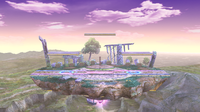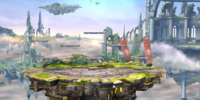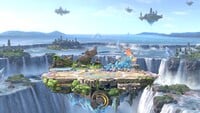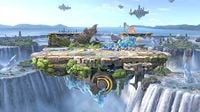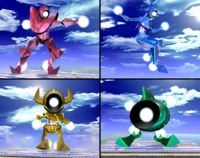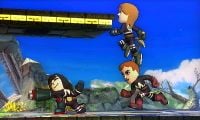Battlefield
Battlefield is a recurring stage within the Super Smash Bros. series, appearing in every installment to date. The stage has been designed specially for the Super Smash Bros. series and does not originate from any other Nintendo franchise. Battlefield is a floating stage consisting of a large floor platform and three smaller pass-through platforms hovering above it. The stage does not have any hazards, like Final Destination, which allows players to solely concentrate on the fight. The design has changed in each installment, with early appearances having it in a dark void and later ones in scenic floating ruins.
In Super Smash Bros., Battlefield is the stage where the Fighting Polygons are battled. However, much like Final Destination, the stage cannot be played in VS Mode.
Super Smash Bros. Melee is the first game to feature Battlefield as a selectable stage. It can be unlocked by completing All-Star mode on any difficulty. In addition, the Fighting Wire Frames as well as the metal enemies are battled on it.
In Super Smash Bros. Brawl, Battlefield returns as a default stage. The stage now takes a natural green landscape as opposed to the abstract background in the previous games. It also features a day and night system that changes the time of day as the battle goes on. The stage is once again the location where the Fighting Alloy Team is battled.
The Super Smash Bros. for Nintendo 3DS / Wii U variations of this stage take a lot from the design of the Super Smash Bros. Brawl version, as it is in a natural green landscape and features a day and night system that changes as the battle goes on, but the background has been improved slightly. The 3DS version's background consists of several jagged, slanted mountains jutting out from the clouds, while the Wii U version features several floating islands of old, broken architecture covered in small plant life, with a visible moon the center. Additionally, the Wii U version has a larger variant named Big Battlefield designed for 8-player matches, though it can still be used by less players. The platforms are arranged similarly to a pyramid and there are three additional platforms. The Ω form of Battlefield removes the pass-through platforms, although the day and night cycle still occurs. This stage shares its Ω form with Big Battlefield.
The Super Smash Bros. Ultimate variation bears a close resemblance to its predecessor, with similarly styled platforms and main arena. Instead of ruined structures, buildings still intact as well as many waterfalls can be seen in the background. Big Battlefield returns as well. Additionally, every stage in the game includes a Battlefield form, which changes the layout of each stage to resemble Battlefield. In the version 8.1 update released on August 4, 2020, Small Battlefield was added, which features only two platforms, making its layout similar to that of Pokémon Stadium. The update also added the ability to play any song in the game on all three variations of Battlefield as well as on Final Destination.[1]
In Super Smash Bros. Melee, the unlock match for Falco takes place here. In Super Smash Bros. for Nintendo 3DS, the unlock match for Duck Hunt takes place here. In Super Smash Bros. Ultimate, the unlock match for Ryu takes place here.
Songs
Super Smash Bros. Brawl
My Music
| Name | Source | Credits | Requirements |
|---|---|---|---|
| Battlefield | Super Smash Bros. Brawl | ||
| Menu (Super Smash Bros. Melee) |
Super Smash Bros. Melee | Arrangement: Motoi Sakuraba | |
| Battlefield Ver. 2 | Super Smash Bros. Brawl | ||
| Battlefield (Melee) | Super Smash Bros. Melee | Original | |
| Multi-Man Melee 1 (Melee) | Super Smash Bros. Melee | Original | Clear 100-Man Brawl in under 4 minutes. |
Not in My Music
| Name | Source | Credits | Plays In |
|---|---|---|---|
| Credits (Super Smash Bros.) | Super Smash Bros. | Arrangement Supervisor: Yusuke Takahama | 10-Man Brawl |
| Cruel Brawl | Super Smash Bros. Brawl | Cruel Brawl | |
| Menu 1 | Super Smash Bros. Brawl | Co-op Event No. 21 ("The True All-Star Battle") |
Super Smash Bros. for Nintendo 3DS
| Name | Source | Credits |
|---|---|---|
| Battlefield | Original | Composition Supervisor: Keiki Kobayashi Composition: BANDAI NAMCO Studios Inc. Arrangement: BANDAI NAMCO Studios Inc. |
| Menu (Melee) | Super Smash Bros. Melee | Arrangement: Motoi Sakuraba Composition: HAL Laboratory, Inc. |
Super Smash Bros. for Wii U
| Name | Source | Credits | Requirements |
|---|---|---|---|
| Battlefield | Original | Composition Supervisor: Keiki Kobayashi Composition: BANDAI NAMCO Studios Inc. Arrangement: BANDAI NAMCO Studios Inc. |
Available by default |
| Multi-Man Smash | Original | Arrangement Supervisor: Yoshihito Yano Composition: BANDAI NAMCO Studios Inc. Arrangement: BANDAI NAMCO Studios Inc. |
Available by default |
| Trophy Rush | Original | Arrangement Supervisor: Katsuro Tajima Composition: BANDAI NAMCO Studios Inc. Arrangement: BANDAI NAMCO Studios Inc. |
Available by default |
| Credits (Super Smash Bros.): Ver. 2 | Super Smash Bros. | Arrangement Supervisor: Ryo Nagamatsu Composition: HAL Laboratory, Inc. Arrangement: Nintendo |
Collect CD |
| Menu (Melee) | Super Smash Bros. Melee | Arrangement: Motoi Sakuraba Composition: HAL Laboratory, Inc. |
Available by default |
| Boss Battle (Melee) | Super Smash Bros. Melee | Arrangement Supervisor: Shogo Sakai Composition: HAL Laboratory, Inc. Arrangement: HAL Laboratory, Inc. |
Available by default |
| Multi-Man Melee 2 | Super Smash Bros. Melee | Original | Clear Solo 100-Man Smash within 3 minutes while playing as Mii Swordfighter |
| Cruel Smash (Brawl) | Super Smash Bros. Brawl | Original | Collect CD |
| Battlefield (Brawl) | Super Smash Bros. Brawl | Original | Available by default |
| Battlefield Ver. 2 (Brawl) | Super Smash Bros. Brawl | Original | Collect CD |
| Boss Battle Song 1 (Brawl) | Super Smash Bros. Brawl | Original | Available by default |
| Menu | Original | Arrangement Supervisor: Junichi Nakatsuru Composition: BANDAI NAMCO Studios Inc. Arrangement: BANDAI NAMCO Studios Inc. |
Available by default |
Multi-Man mode enemies
Fighting Polygons
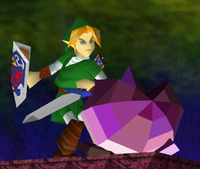
- SmashWiki article: Fighting Polygon Team
The Fighting Polygons (also called the Fighting Polygon Team) are a group of weak enemies found in Super Smash Bros. They possess very little attack and defense prowess, but their numbers can pose a threat (the player fights 30 of them in the penultimate stage of the 1P Game).
Their bodies are all the characters' basic polygon structure (hence their name), all colored purple. Their designs appear edited from the original mode. They do not have the voices of the characters they are modeled after, making them completely silent. For example, Kirby's version appears as a cake, and Yoshi's version has three teeth. Mario, Luigi and Ness' versions look very similar to each other, only being told apart by their moving pattern (Ness's version makes the same glittering noise of the real Ness when jumping) and that the Ness one's nose is lower than Mario one's nose.
Names in other languages
| Language | Name | Meaning |
|---|---|---|
| Japanese | 謎のザコ敵軍団 Nazo no zakoteki gundan |
Mysterious Small Fry Enemy Corps |
Fighting Wire Frames
- SmashWiki article: Fighting Wire Frames
The Fighting Wire Frames appear in Super Smash Bros. Melee, replacing the Fighting Polygons. Wire Frames have the same attack pattern as Zelda and Captain Falcon (minus the special moves), and are constructed of purple wires with internal organs visible. Fighting Wire Frames can be fought in a Stadium Mode called Multi-Man Melee. Six different scenarios can be chosen here, 10-Man Melee, 100-Man Melee, 3-Minute Melee, 15-Minute Melee, Endless Melee, or the expert leveled Cruel Melee.
Names in other languages
| Language | Name | Meaning |
|---|---|---|
| Japanese | 謎のザコ敵軍団 Nazo no zakoteki gundan |
Mysterious Small Fry Enemy Corps |
| Italian | Sagoma |
Shape |
Fighting Alloy Team
- SmashWiki article: Fighting Alloy Team
The Fighting Alloy Team appears in Super Smash Bros. Brawl, replacing the Fighting Wire Frames. The four kinds of Alloys are the Red Alloy, Blue Alloy, Yellow Alloy, and Green Alloy. Each Alloy resembles a playable character's moveset:
- Red Alloy: Captain Falcon
- Blue Alloy: Zelda
- Yellow Alloy: Mario
- Green Alloy: Kirby
The Fighting Alloy Team makes an appearance in Super Smash Bros. Ultimate as an Advanced-class support spirit that occupies one support slot. Fighters that use this spirit will start a battle with a Ray Gun. The spirit battle takes place on the Battlefield form of Final Destination, where the player faces four Captain Falcons, four Zeldas, four Marios and four Kirbies.
Names in other languages
| Language | Name | Meaning |
|---|---|---|
| Japanese | 謎のザコ敵軍団 Nazo no zakoteki gundan |
Mysterious Small Fry Enemy Corps |
| Chinese | 謎之雑兵軍團 Mí zhī zábīng jūntuán |
Mysterious Small Fry Enemy Corps |
| German | Metalloid |
from Metall (metal) + (An)droid (android) |
| Italian | Zaamar |
? |
Fighting Mii Team
- Main article: Mii § Super Smash Bros. series
- SmashWiki article: Fighting Mii Team
The Fighting Mii Team appears in Super Smash Bros. for Nintendo 3DS / Wii U and Super Smash Bros. Ultimate, replacing the Fighting Alloy Team. Unlike the previous teams whose characters have a set appearance, the Fighting Mii Team uses Miis that are saved in the player's system; the Miis' heads are loaded onto a pre-set body and are randomly given either the Mii Brawler, Mii Swordfighter, or Mii Gunner moveset, albeit without special moves, grabs, and the abilities to pick up items and grab ledges.
Events
- No 1: Trouble King (Melee)
- No 36: Space Travelers (second half) (Melee)
- No 37: Legendary Pokémon (Melee)
- No 44: Mewtwo Strikes! (Melee)
- No 20: All-Star Battle x 1 (Brawl)
- Co-op No 21: The True All-Star Battle (Brawl)
Trophy information from Super Smash Bros. Melee
Gallery
Names in other languages
Battlefield
| Language | Name | Meaning |
|---|---|---|
| Japanese | デュエルゾーン (Super Smash Bros.) Dyueru Zōn 戦場 Senjō |
Duel Zone Battlefield |
| Chinese | 戰場 (Traditional) 战场 (Simplified) Zhànchǎng |
Battlefield |
| Dutch | Slagveld |
Battlefield |
| German | Schlachtfeld |
Battlefield |
| Italian | Le rovine |
The ruins |
| Korean | 전장 Jeonjang |
Battlefield |
| Portuguese | Campo de Batalha |
Battlefield |
| Russian | Поле боя Pole boya |
Battlefield |
| Spanish | Campo de batalla |
Battlefield |
Big Battlefield
| Language | Name | Meaning |
|---|---|---|
| Japanese | 大戦場 Daisenjō |
Big Battlefield |
| Chinese | 大戰場 (Traditional) 大战场 (Simplified) Dà zhànchǎng |
Big Battlefield |
| Dutch | Groot Slagveld |
Big Battlefield |
| German | Großes Schlachtfeld |
Big Battlefield |
| Italian | Le rovine XL |
The XL ruins |
| Korean | 대전장 Dae Jeonjang |
Big Battlefield |
| Portuguese | Campo de Batalha XL |
Battlefield XL |
| Russian | Большое поле боя Bol'shoye pole boya |
Big Battlefield |
| Spanish | Gran campo de batalla |
Big Battlefield |
Small Battlefield
| Language | Name | Meaning |
|---|---|---|
| Japanese | 小戦場 Kosenjō |
Small Battlefield |
| Chinese | 小戰場 (Traditional) 小战场 (Simplified) Xiǎo zhànchǎng |
Small Battlefield |
| Dutch | Klein Slagveld |
Small Battlefield |
| French | Petit Champ de Bataille |
Small Battlefield |
| German | Kleines Schlachtfeld |
Small Battlefield |
| Italian | Le rovine XS |
The Ruins XS |
| Korean | 소전장 So Jeonjang |
Small Battlefield |
| Russian | Маленькое поле боя Malen'koye pole boya |
Small Battlefield |
| Spanish | Pequeño campo de batalla |
Small Battlefield |
Trivia
- In Super Smash Bros., its theme seems to be an arrangement of the music for Mario's castle in Super Mario Land 2: 6 Golden Coins.
References
- ^ @NintendoAmerica (August 4, 2020). "A Super #SmashBrosUltimate update, Ver. 8.1.0, is available now! This update includes a new stage, Small Battlefield. Plus, you’ll now be able to select from all music tracks when playing on Final Destination and Battlefield stages!" Twitter. Retrieved August 4, 2020.
| Super Smash Bros. | ||||
|---|---|---|---|---|
| Playable characters | Donkey Kong • Fox • Kirby • Link • Luigi • Mario • Yoshi • Others | |||
| Non-playable characters | Bob-omb • Whispy Woods | |||
| Bosses | Giant Donkey Kong • Metal Mario | |||
| Stages | Peach's Castle • Yoshi's Island • Congo Jungle • Hyrule Castle • Mushroom Kingdom • Others | |||
| Items | Barrel • Bob-omb • Crate • Egg • Fire Flower • Green Shell • Hammer • Red Shell • Star • Star Rod • Target | |||
| Moves | Miscellaneous | Jump • Taunt | ||
| Special | Standard | Up | Down | |
| Mario | Fireball | Super Jump Punch | Mario Tornado | |
| Luigi | Green Fireball | Luigi Cyclone | ||
| Donkey Kong | Giant Punch | Spinning Kong | Hand Slap | |
| Yoshi | Egg Lay | Egg Throw | Yoshi Bomb | |
| Other | Gallery • Glitches • Pre-release and unused content • Quotes • Staff | |||
